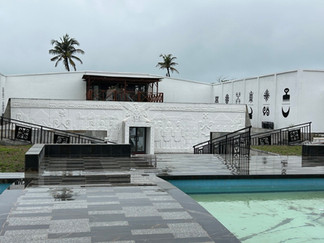SANKOFA RETURN, PART 1
- Vivian Phillips
- Aug 23, 2023
- 5 min read
August 2019 marked the 400th anniversary of the first Africans being stolen from their Ghana homeland and shipped to America. The Ghanaian government marked this anniversary by deeming it The Year of Return, which invited thousands of Africans in diaspora to flock to the shores of their ancestral homeland.
The designation of this 400th anniversary was reason for many, to throw off those procrastinations and hesitations about traveling to Africa, and to just go. But if you didn’t go in 2019, or if you have never been to the home of our ancestors, here’s a nudge to not wait. Make that trek. You will be glad you did.
Within the past year, I’ve had the pleasure of returning to Ghana twice. The people, the cultures, the food, and the ancestral memory that wells up inside, draw me in and embrace my spirit. My cup is always filled when I step onto the African soil.
Ghana has one of the fastest growing economies in the world, yet there remain constant threats to sustained growth due to high costs of energy and low access to credit. You can imagine that, as is the case across the continent, foreign interests have their eye on this vast oasis and in many ways pose a post colonial-like threat to the country. Ghana’s history as the first Black nation to gain independence from colonial rule is a history to be remembered. This is a history of not just rebellion and revolution, but a history that illustrates the intellectual might of an ancient kingdom. Ghana is obviously a place of great pride and history.
Now that you’re all set to go: passport in hand, Visa application complete, air travel and accommodations settled, here are a couple of recommendations of must-see experiences:
The dungeons at Cape Coast and Elmina still teem with the haunting presence of Africans who were essentially stored in horrific environments. The spiritual and ancestral presence can be felt upon approach. I feel it is my duty to step inside those places of pain and death whenever I can, to honor the lives of my stolen ancestors.
Another slave dungeon that is not a popular tourist stop is right inside Accra. The slave fort at James Town was built by the British as a trading post for gold and slaves in the 17th century. After slavery was abolished, Fort James served as a prison until 2008. Kwame Nkrumah, who led Ghana’s decolonization process, and became Ghana’s first President, was held there from 1950-1951 after being arrested for leading a disturbing campaign against British rule.
James Fort has not been preserved in the same way as the more touristy slave dungeons at Cape Coast have and is now a UNESCO heritage site. But if you travel with the right guide, chances are you can get a quick visit. Also, if you happen to be in Detroit and visit the Detroit Institute of Arts, you can grab a look at the photography retrospective of Ghanaian native James Barnor whose first photo studio was located just adjacent to James Fort.
Speaking of Kwame Nkrumah, the memorial and mausoleum dedicated to him in Accra had been closed for a bit while undergoing upgrades and renovation, and the wait was well worth it. The latest upgrades have created a renewed interest in the life and history of the first Ghanaian President. The underground museum strategically located directly behind his tomb, offers detailed information on his education, his political savvy, his dedication to his country, and his forward vision for the economic future of Ghana. The exterior of the memorial has been beautifully restored and a new wing now houses artifacts including Nkrumah’s official vehicle.
I am not African because I was born in Africa, but because Africa was born in me. - Kwame Nkrumah
The creative culture of Ghana shows up everywhere. In the food, architecture, fashion, history, people, and geographic landscape. A visit to the Aburi Botanical Gardens can be off the beaten path but well worth the travel. About a 45-minute drive outside of Accra in the Akwapim-Togo Range, the garden is a feast of nature. Our guide, who had been working on the garden grounds for over 30 years, introduced and welcomed us by saying that every spice known to man is present there. The gardens are filled with trees and plants that excite the senses, and one incredible tree carving that blew me away. The tree depicts a series of scenes with people from all walks of African life who can be seen either lifting one another up to help the climb to the top or pulling one another down. Which do you see first?

No trip to Ghana is complete without a trip to a beach. Beaches surround Accra and the Cape Coast, so you are bound to happen upon or near one during your stay. My travel partner and I had the pleasure of being introduced to Bojo Beach for an afternoon of cold brews and beach breezes. It’s a bit out of the regular path located at the delta of the Densu River and the Atlantic Ocean, but that’s what makes it so appealing. Once you exit the main highway, a bumpy, potentially Dramamine-inducing 40-minute or so trek on the back road leads to the entryway to the resort area. Once there, access to the beach requires a short boat ride across the bay to arrive at the most relaxing and sparsely populated beach available. If you go on a weekend evening, you won’t even notice the bumpy roads because the distraction of music and weekend party preparations will capture your attention for certain. Get into it.
For art lovers like me, there are a few places that are both on and off the beaten path. The Arts Cultural Center is a robust center where intricate carvings are being crafted and visual artists are churning out beautiful displays of Ghanaian still life, freshly packaged shea butter is abundant, drums are being carved and played, fabrics float on wall displays and in folded bundles on the ground, and basically, anything you can imagine is available. Looking for mudcloth, they have it. Beads, yep! Ready to wear clothing, you got it. Just mention the arts center and everyone knows how to get you there.
If interested in more ancient art in a shared space with contemporary art, then Omanye House is the place for you. This is the home of the Artist Alliance Gallery and trust me, plan to set aside at least a couple of hours to explore 4 floors of sculptures, ancient masks and shields, and galleries crowded with the works of hundreds of Ghanaian artists.
In part two, look for recommendations for restaurants, more art, hidden gems, and other hot spots, all to get you geared up for your own Return.


























Comments